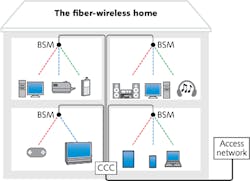While the introduction of radio-frequency (RF) wireless (WiFi) a number of years ago had the almost magical effect of eliminating the need for Ethernet cables to every single internet-connected device in the home, WiFi sometimes suffers from interference among devices, limited bandwidth, and limited RF spectrum. As a replacement, home optical wireless—or at least the concept—has great appeal: almost limitless bandwidth and (unregulated) spectrum availability, and no interference between devices.
While the concept seems sound, it’s the implementation that has not yet been settled on. For example, one approach, modulating LED house lighting and placing optical receivers on devices to capture the signal, has limitations on bandwidth.
Now, Researchers at Eindhoven University of Technology (The Netherlands) have introduced a concept (and backed it up with experimentation) that uses a steerable modulated laser beam; the prototype has already reached a 10 Gbit/s bandwidth.1
Experiment
In the setup, a “pencil” beam produced by a tunable laser is directed to a device using a passive diffractive optical element (DOE); changing the wavelength of the laser changes the beam angle exiting the (DOE), thus aiming the beam.
In the experiment, a laser beam tunable between 1500 and 1630 nm was directed through a 1D diffraction grating; the experiment was carried out over a free-space transmission distance of 2.5 m using on-off keying (OOK) non-return-to-zero (NRZ) modulation. The proof-of-concept used a grating with 79 grooves/mm and a 75° blaze angle, using the 15th and 16th orders for the laser wavelengths. The resulting steerable beam angle was about 17° (a spatial coverage of 772 mm in the experiment).
The experiment took into account the fact that the maximum available optical output from the laser is a function of wavelength. Data rates of 10, 5, 2.5, and 1.25 Gbit/s were measured; all “eye” diagrams were clear and open, showing that good-quality signals were received.
An optical-wireless-equipped home would contain a central communication controller (CCC) that would direct data via optical fiber to beam-steering modules (BSMs) placed around the house (see figure). Each data device in the room would include an optical receiver.
The Eindhoven University of Technology did not concern itself with any of the more sophisticated operations of a hypothetical optical wireless system, such as how a device would capture and lock on to a signal, or how a signal would be shared among multiple devices. In addition, an optical wireless system has the potential disadvantage of greater limits on arbitrary placement of devices within a room due to the need for a relatively direct path between the data transmitter and receiver.
The researchers also recognize that the spatial coverage distance of their prototype is too small for practical use; future research will concentrate on producing larger steering-angle coverage.
REFERENCE
1. C. W. Oh et al., Opt. Lett., 39, 5427 (Sept. 15, 2014).

